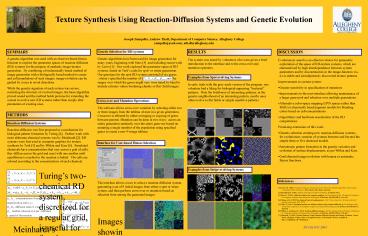Texture Synthesis Using ReactionDiffusion Systems and Genetic Evolution - PowerPoint PPT Presentation
1 / 1
Title: Texture Synthesis Using ReactionDiffusion Systems and Genetic Evolution
1
Texture Synthesis Using Reaction-Diffusion
Systems and Genetic Evolution
Joseph Zumpella, Andrew Thall, Department of
Computer Science, Allegheny College zumpellaj_at_aol.
com, athall_at_allegheny.edu
SUMMARY
Genetic Selection for RD-systems
RESULTS
DISCUSSION
A genetic algorithm was used with an
observer-based fitness function to explore the
parameter spaces of reaction-diffusion (RD)
systems for the purpose of aesthetic
image-texture generation. By combining a
biochemically based method of image generation
with a biologically based method to create and
cull populations of such images, image-evolution
can be guided by a user in novel
directions. While the genetic signature of each
system was severe, restricting the diversity of
evolved images, the basic algorithm proved sound
and the method holds promise for extending the
system to evolve new RD systems rather than
simply alter parameters of existing ones.
Genetic algorithms have been used for image
generation for many years, beginning with Sims
3 and including recent work by Lewis 1. Our
work explored the parameter space of RD systems,
based on Turks code for spot- or
stripe-generation. Our genotype for the spot RD
system consisted of six genes
, where i specified the number of
iterations to perform. The ranges over which the
genes might vary were tuned by hand to include
extreme values bordering chaotic or flat- field
images.
The system was tested by volunteers who were
given a brief introduction to the interface and
to the cross-over and mutation operators.
- Evolutionary search is an effective choice for
parametric exploration of the space of RD-texture
systems, which are characterized by high
interdependence between system parameters and by
discontinuities in the image-function vis-à-vis
stable and serendipitously discovered texture
patterns. - Improvements to current system
- Greater sensitivity in specification of mutations
- Improvements to the user-interface allowing
maintenance of a larger gene-pool and selection
over multiple generations. - Alternative color-space mapping (HVS spaces
rather than RGB) or chemically based pigment
models for blending colors based on
cell-concentrations - Algorithmic and hardware acceleration of the RD
computations - Promising extensions of this work
- Genetic selection creating new reaction-diffusion
systems, for evolutionary creation of systems
between and beyond the simple three or five
chemical models. - Anisotropic pattern formation in the genetic
variation and evolution of surface displacements,
as per Witkin and Kass. - Goal-directed image-evolution with human or
automatic fitness functions.
Examples from Spot-evolving Systems
In early trials with the grey-scale version of
the program, one volunteer had a liking for
biological-appearing bacterial patterns. Note
the brittleness of interesting patterns in the
genetic neighborhood of an interesting pattern,
nearby ones often evolve to flat fields or simple
repetitive patterns.
Cross-over and Mutation Operations
The software allows cross-over variation by
selecting either two or three images from the
tableau of nine in a given generation. Crossover
is effected by either averaging or copying of
genes between parents. Mutation can be done in
two ways across an entire generation randomly
over the entire gene-set based on mutating a
single member of the population using specified
genes to create a new 9-image tableau.
METHODS
Reaction-Diffusion Systems
Reaction-diffusion was first proposed as a
mechanism for biological pattern formation by
Turing 4. Further work with more elaborate
chemical systems was by Meinhardt 2. RD systems
were first used in computer graphics for texture
synthesis by Turk 5 and by Witkin and Kass 6.
Simulated chemicals have concentrations that
vary across a grid of cells they diffuse across
the grid and react with one another until
equilibrium is reached or the reaction is halted.
The cells are colored according to the
concentrations of each chemical.
Interface for User-based Fitness Selection
Examples from Stripe-evolving Systems
Turings two-chemical RD system, discretized for
a regular grid, is useful for forming spotted
patterns 5.
References
The interface allows a user to select a
reaction-diffusion system, generating a set of 9
initial images from either a spot or stripe
system, and then perform cross-over or mutation
based on selection from among the generated
images.
- 1 Lewis, M. (2001) Creating Continuous Design
Spaces for Interactive Genetic Algorithms with
Layered, Correlated Pattern Functions. Ph.D.
thesis, Ohio State University. - 2 Meinhardt, H. (1982) Models of Biological
Pattern Formation, Academic Press. - 3 Sims, K. (1991) Artificial evolution for
computer graphics. In Proceedings of the 18th
Annual Conference on Computer Graphics and
Interactive Techniques, ACM Press, SIGGRAPH 91,
319-328. - 4 Turing, A.M. (1952) The chemical basis of
morphogenesis. Phil. Trans. Royal Soc. of London
Series B Biological Sciences, 237, 37-72. - 5 Turk, G. (1991) Generating textures on
arbitrary surfaces using reaction-diffusion. In
Proceedings of the 18th Annual Conference on
Computer Graphics and Interactive Techniques, ACM
Press, SIGGRAPH 91, 289-298. - 6 Witkin, A. and Kass, M. (1991)
Reaction-diffusion textures. In Proceedings of
the 18th Annual Conference on Computer Graphics
and Interactive Techniques, ACM Press, SIGGRAPH
91, 299-308. - 7 Zumpella, J. (2004) Texture Synthesis Using
Reaction-Diffusion Systems and Genetic Evolution.
Senior thesis, Allegheny College, Dept. of
Computer Science, Tech Report CS04-16, available
at http//cs.allegheny.edu/thall/papers.
Images showing new generations of spot (left) and
stripe (right) patterns after several cross-over
operations.
Meinhardts five-chemical RD system, is useful
for forming striped patterns 5.
SIGGRAPH 2004































